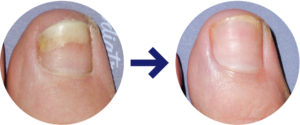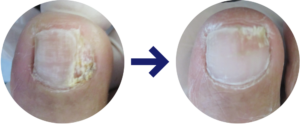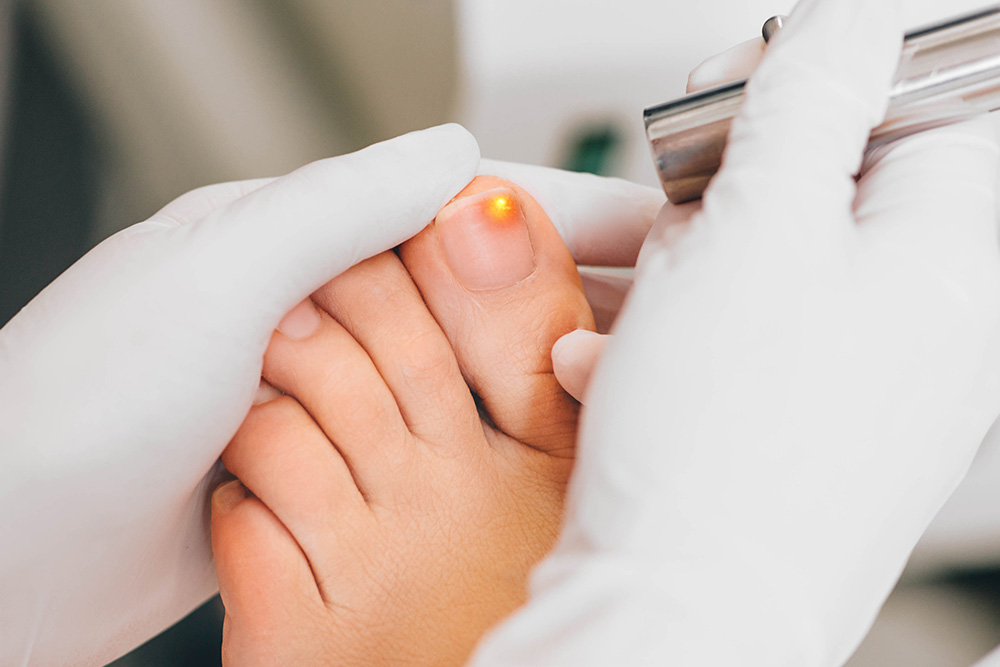
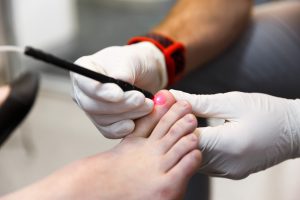 If you’ve noticed white or yellow spotting or streaking on your toenail and are worried you’ve picked up a fungal nail infection – you’re not alone!
If you’ve noticed white or yellow spotting or streaking on your toenail and are worried you’ve picked up a fungal nail infection – you’re not alone!
Fungal toenail infections, medically known as onychomycosis, affect approximately 10% of the population in Australia. Unfortunately, this rate only increases as we get older, with up to 50% of people over the age of 60 having one or more nails infected.
Thankfully, My FootDr has taken advantage of the technological advancements in recent years, meaning that we can treat these fungal nail infections more effectively than ever before using anti-fungal laser treatment. This means no more daily creams, lacquers or tablets.
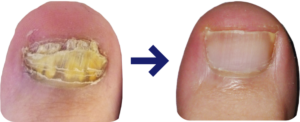
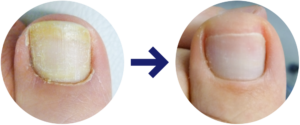
What causes fungal nail infections?
Fungal nail infections are caused by the infiltration of the nail bed and nail plate by a fungus. While there are many types of fungus, including those that naturally move through the air outside, the kind of fungus that causes nail infections is most often spread through direct contact with someone that is infected. These infections are often picked up in public pool areas, changing rooms, public showers and gyms because fungus thrives in warm and moist environments.
The fungus feeds on the keratin within your nails, which causes the damaged appearance. This means that once you have an infection, your sneakers and work boots can be an ideal space for the infection to grow and spread – so the earlier you start treating the infection, the easier it is.
 Signs that you may have nail fungus include:
Signs that you may have nail fungus include:
- A white or yellow discolouration or streaking of the nails
- Rougher nail ridges or thickened nails
- Crumbling, flaky or brittle nails
- The nail may start to lift up and come away at the end
How do we treat fungal nail infections?
We no longer recommend the use of creams, lacquers or sprays on their own because of the poor results from both clinical studies and our experience. Instead, we use two different types of laser to safely and effectively help treat fungal nail infections – with minimal hassle for you.
We have both hot and cold laser available at different clinics, and your podiatrist will recommend the best treatment option for you based on your symptoms and severity.
Hot or cold laser treatment for fungal nail infections?
 Thermal (hot) laser treatment easily and effectively penetrates the nail and generates heat at the site of infection beneath the nail plate. The fungal cells are destroyed (before your healthy cells are damaged), meaning laser therapy is pain-free. All you will feel is a warm sensation at your nail.
Thermal (hot) laser treatment easily and effectively penetrates the nail and generates heat at the site of infection beneath the nail plate. The fungal cells are destroyed (before your healthy cells are damaged), meaning laser therapy is pain-free. All you will feel is a warm sensation at your nail.
Cold laser fungal nail treatment uses two low-level beams simultaneously on the nail to both damage the living fungus and help your body clear the infection. The frequency of the beams doesn’t generate any heat, hence they are called ‘cold’ lasers. This also means that the treatment is safe, pain-free and has no side effects.
Laser treatment does not require any local anaesthesia, and there is no recovery period. It’s a simple walk-in, walk-out procedure with no side effects and no visible harm to the nail or skin.
It’s important to note that nails have no living cells – even healthy-looking nails. This is an important point as a dead cell has no potential to fight off an infection and heal. This means that once the laser treatment is complete and the fungal cells have been destroyed, the damage from the fungus will not be reversed. As the healthy nail grows out, the damage will slowly disappear, though this will take several months.
What can you expect at a laser treatment appointment?
At My FootDr podiatry centres, we don’t just treat your fungus, but also help prevent it from coming back. Each new appointment starts with a comprehensive assessment to ensure that we select the best treatment for you, and really get to the cause of the problem. This includes:
- Confirming that you have a fungal nail infection (as opposed to another condition that appears like a fungal nail infection)
- A review of the cause of the infection, so we can address this
- A treatment plan outlining the most appropriate management, both short and long-term
- Measures to ensure that once the fungal nail infection is eradicated, the chances for re-infection are minimised
The number of laser treatments you will require is determined by the number of infected nails, severity of the fungal nail infection, your age and general health. Your podiatrist will advise on the number of laser therapy appointments recommended for your treatment, but generally, 3-6 treatments are required.
Fungal Nail Infection FAQs
Can a fungal nail infection cure itself?
Fungal nail infections typically do not go away on their own without some sort of antifungal treatment. This is because it will usually have everything it needs to grow and thrive, including an endless food source from the keratin that your growing nails are made of.
If you suspect one of your nails has a fungal infection, you should make an appointment with a qualified podiatrist to assess the area and recommend a treatment plan. This is one of our specialities, and we have a range of world-class treatments, including both hot and cold laser, that are proven to have the highest clearance rate of any other anti-fungal treatment currently on the market.
Which fungus causes fungal nail infections?
Fungal nail infections can be caused by a variety of fungal organisms. The most common type of fungus is called a dermatophyte, a group of fungi that require keratin for growth. Nail infections can also be caused by different yeasts and moulds.
Sometimes, a nail that appears to have a fungal nail infection is actually suffering from a different problem instead, like psoriasis. Your My FootDr podiatrist will help make this important difference and prevent you from wasting time and money treating the wrong condition.
How do fungal nail infections spread?
Fungal nail infections spread through direct contact with someone who is infected, or through coming in contact with the same surface they have been in contact with, like floors, showers, socks and shoes. As fungus thrives in warm and moist environments, public pool and shower areas, gyms, and changing rooms are the most common places to contract a fungal nail infection. Once you have the infection, it can grow and spread to your other nails inside your sneakers or work boots. You may also contract Athlete’s foot in the same way.
Are fungal nail infections contagious?
Fungal nail infections can be contagious from nail to nail, and are transmitted through sharing surfaces as mentioned above, but they are not ‘contagious’ in the traditional sense, unless you are in close intimate contact or if you share the same quarters. This means it can be spread among families, but you are unlikely to catch it during normal daily activities with an infected person.
Does laser treatment for fungal nail infections hurt?
We offer two types of laser to treat fungal nail infections: cold laser and hot laser. Neither of these treatments are painful. Cold laser is completely painless, as it uses two cool wavelengths of light simultaneously to clear the fungal infection. We have never had any patient complain of any pain with this treatment.
Hot laser uses heat to act on the fungus, however, this is not typically painful. You may feel a warm sensation over your nail as the laser is applied. This is controlled by your experienced podiatrist, so if you’re worried then know they can pause the treatment instantly if you feel any discomfort. Your safety is our priority.
What is the best treatment for fungal nail infections?
Laser treatment has the highest efficacy and clearance rates as published in clinical studies. Both hot and cold laser have been found to be superior to both topical creams and ointments, as well as oral prescription medication.
Can my fungal nail infection come back?
It can. Just like how you can stub your toe multiple times on different occasions, you may contract fungal nail infections on different occasions and from different places, too. As part of your care, we will discuss with you the best ways to keep your home environment free from fungus to limit your risk of reinfection from places like your shoes, socks and shower at home.


